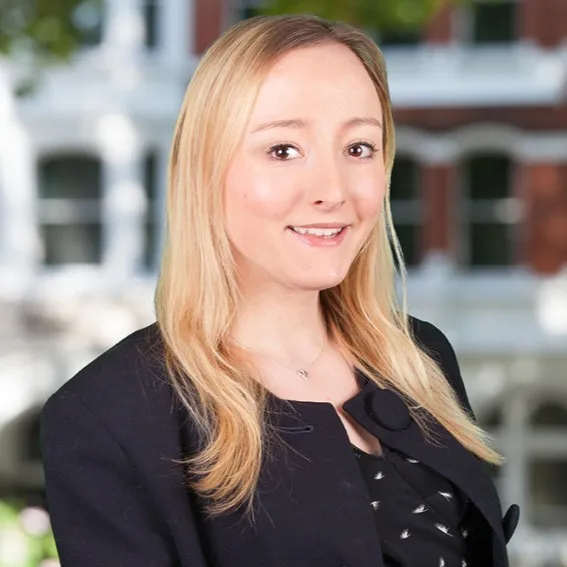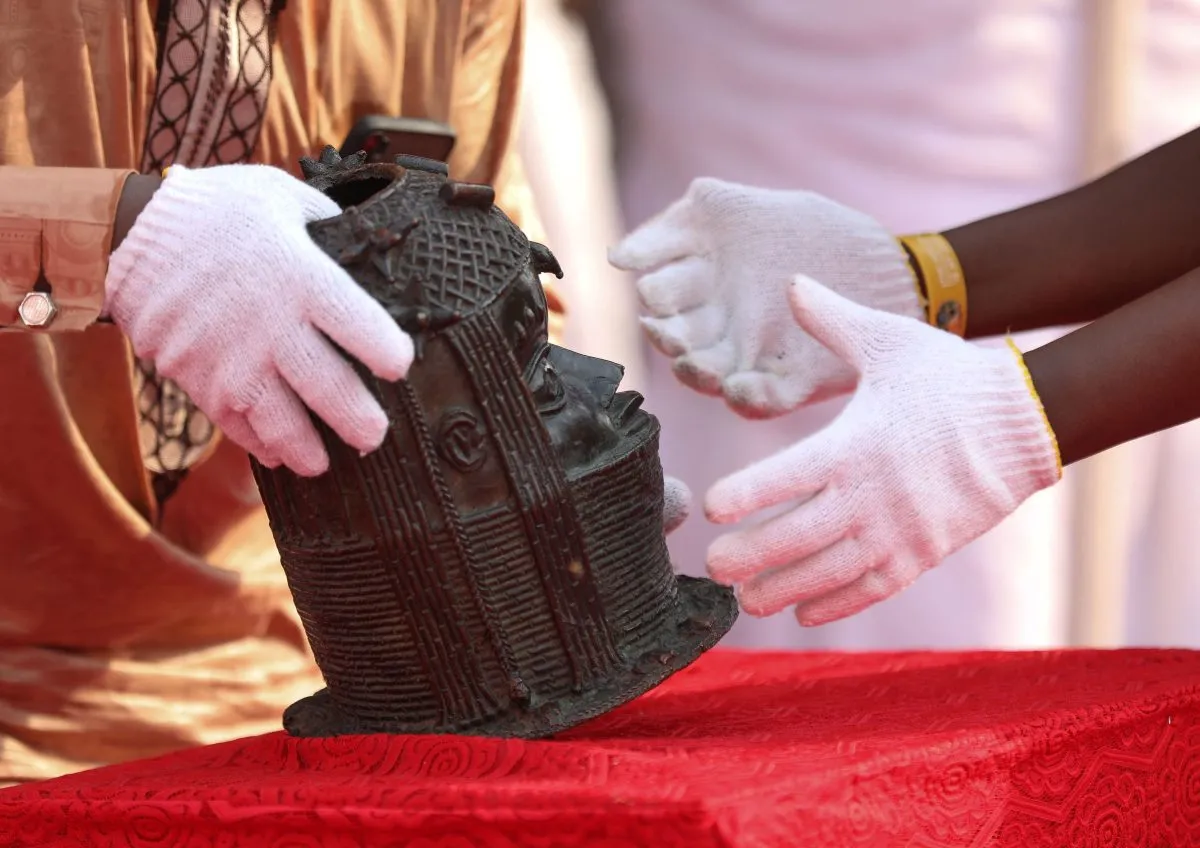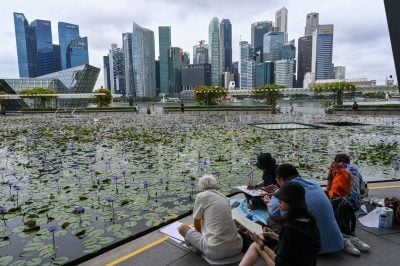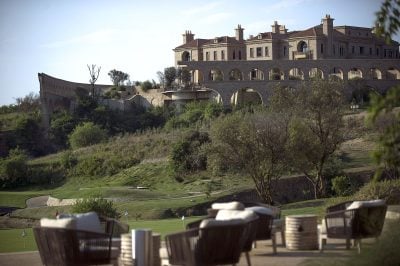In a historic moment for Africa’s cultural and artistic heritage, the Museum of West African Art (MOWAA) opened its doors earlier this month in Benin City, Nigeria. An ambitious project that has been years in the making, MOWAA aims to redefine museum practices within the African continent, and to position it as a leader in the fields of archaeology, conservation, and collections management.
Yet it aims to be so much more than just a museum – it strives to be a living institution that aims to foster collaboration and innovation. Lagos-based abstract artist Nengi Omuku describes the opening of MOWAA as “a great opportunity for artists to access art [that] we have admired for so long but may have only seen in books”.
The museum will comprise a multitude of buildings and outdoor spaces spread across a 15-acre campus, located within the walls of the ancient moats of the Benin Kingdom. The creation of the first building, which opened this month, paid homage to the city’s origins by integrating traditional West African rammed-earth techniques with modern architectural ideas, and is designed to global sustainability standards.
MOWAA aims to both reclaim and elevate the legacy of West African art, while providing an educational and collaborative platform for contemporary and future creative voices and academics.
Speaking to Punch, Shadreck Chirikure, professor of archaeological science at the University of Oxford and adviser to MOWAA, described it as “an art gallery, a collection repository, a centre for research, and a platform for bringing artists and communities together to co-curate and co-create heritage”.
The grand opening
At its heart, the new museum complex is a place to facilitate education, research, and creativity in a historic city that has become a byword for the looting of stolen art by colonial powers. For centuries, the Edo people of Benin were some of the foremost creators of bronze sculptures, plaques and statues; the world-famous Benin bronzes were skilfully created over hundreds of years by artists working for specialist guilds in the royal court of the Oba (king) in Benin City. Thousands were looted in 1897. Some of them currently sit in the British Museum, almost 3,000 miles from their homeland.
Acknowledging the past while looking to the future, MOWAA aims to be a museum for the 21st century, and the campus will also contain a rainforest gallery, a performance venue, a science lab, a boutique hotel, and a sculpture park, alongside artist studios, research facilities, and educational spaces. The atrium is expected to open in mid-2025 and will host MOWAA’s long-term collection, displaying archaeological finds alongside historical relics from Benin’s past, and a special exhibition gallery will be used for temporary shows.
The museum hasn’t opened its first building without fanfare; to celebrate, MOWAA held a live archaeological dig in partnership with the British Museum, the German Archaeological Institute and the Nigerian National Commission for Museums and Monuments, which continued excavation work that has been ongoing for several years. Archaeological finds to date, including pottery that is over 800 years old, will form part of the inaugural exhibition, opening in May 2025. MOWAA also held several workshops to welcome visitors which, Chirikure told Punch, aims to “start an open dialogue on what it means to be an African museum in the 21st century”.
Will the Benin bronzes return?
MOWAA was conceived and established during a time when the conversation around Western museums repatriating, or pledging to repatriate, stolen artefacts had increased substantially in volume (pictured: a sculpture looted by British soldiers in 1897 is repatriated to the Oba of Benin in 2022).
Chirikure believes that MOWAA has the potential “to be among the best in the world for holding returning objects,” and that the opening of MOWAA will “put to bed the idea that Africa has no space and capacity to look after its heritage”.
In February 2022, two Benin bronzes, an Oba bust and a bronze cockerel, were received at the royal palace in Benin City by the Oba of Benin, Ewuare II, after being returned by the University of Aberdeen and Jesus College, Cambridge. In 2023, the outgoing Nigerian president Muhammadu Buhari controversially decreed that the Oba of Benin is the rightful owner and custodian of all the bronzes, which led the University of Cambridge’s Museum of Archaeology and Anthropology to delay the planned return of 116 artefacts.
Phillip Ihenacho, the executive director and chairman of MOWAA, stated that the museum “is available as and when we are needed” to conserve or exhibit the bronzes” but also asserted that “[we] don’t want to get further entangled in any sort of dispute around to whom these objects should be returned.”
Some objects that will be on display at MOWAA, however, include a Malinese pendant dated between the 13th and 15th century, and an Ibwese carving.
Educating future historians
Yet MOWAA’s focus is as much about educating future African historians as showcasing past relics and, speaking to the Nigerian Tribune, Chirikure called MOWAA “a rare breed of African museum, that will train a new generation of African researchers at home [and become] a first-world institution in Africa”.
Ore Disu, director of the MOWAA Institute, acknowledges that access to grant funding for African research and educational institutions, and conservation facilities and resources, have been limited on the African continent but, speaking to Punch, she confirmed that “[our] focus will be to develop professionals with marketable skills, while expanding African-led scholarship,” and stated that one of her first priorities will be to establish conservation and collections management practices that can be transferred between museums. Disu is already looking ahead to conservation partnerships with other museums in Nigeria and countries including Senegal and Ghana.
Funding for MOWAA is projected to reach over $100m, including construction and an endowment fund to cover operational costs, according to Ihenacho. So far, MOWAA has raised around $20m from sponsors including the Open Society Foundation, the Deutsche Gesellschaft für Internationale Zusammenarbeit, and the state of Edo, where Benin City is located. The US-based Mellon Foundation recently gave a $3m grant for MOWAA’s training programmes, including residencies and arts management and conservation. The funding is planned for several stages, and Ihenacho hopes that by the end of 2025 they will have raised enough to fund two more of the planned buildings.
Aindrea Emelife, curator of MOWAA, was instrumental in organising auction house Christie’s financial support of MOWAA initiatives including a Nigerian Pavilion at the 2024 Venice Biennale. She asserts that the opening of the museum in Benin “is not just an opportunity for Africa, but for the world”.
In time, MOWAA plans to partner with universities and institutions around the world to redefine how African art is perceived, studied, and celebrated globally. For the global art community, MOWAA represents a chance to engage with African art on its own terms, appreciating its complexity and significance within its original context.
Want to continue reading? Subscribe today.
You've read all your free articles for this month! Subscribe now to enjoy full access to our content.
Digital Monthly
£8.00 / month
Receive full unlimited access to our articles, opinions, podcasts and more.
Digital Yearly
£70.00 / year
Our best value offer - save £26 and gain access to all of our digital content for an entire year!

 Sign in with Google
Sign in with Google 



